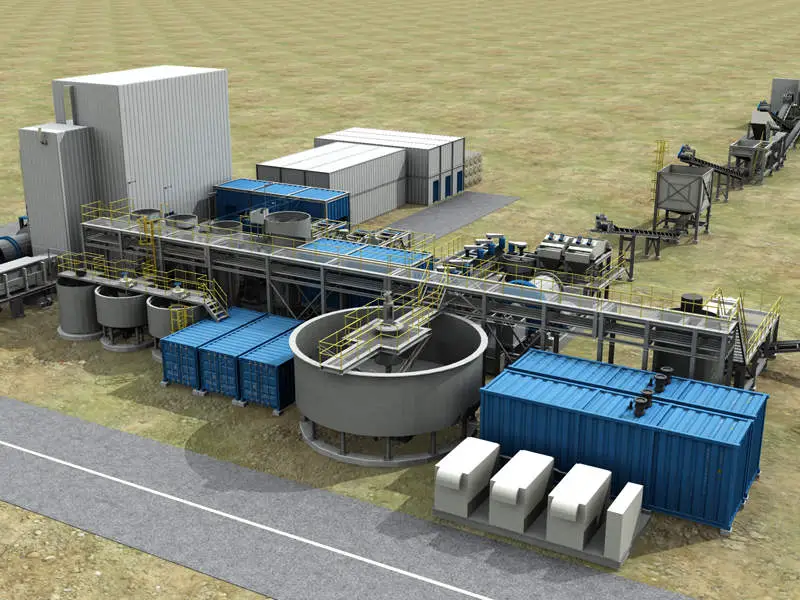Construction of a solar and battery hybrid power plant for Phase 1 of the Molo Graphite Mine Project in Madagascar has begun according to NextSource Materials. The works are being carried out by CrossBoundary Energy (CBE) Madagascar subsidiary.
On November 23, 2021, CBE was chosen to develop, own, and operate the solar, battery, and thermal hybrid energy power plant for a 20-year term. A 2.6MW solar PV facility, a 1MWh battery energy storage system, and a 3.1MW thermal facility will comprise the hybrid plant (diesel generators). The facility will be built next to the Molo mine and will generate up to 33% of the mine’s entire Phase 1 electricity demands using sustainable solar energy, with the balance coming from thermal generators.
The hybrid plant’s development has commenced, and all essential approvals to begin building the solar facility have been received. The thermal, solar, and BESS are all planned to be constructed and operational ahead of the start of Molo processing plant commissioning in Q3 2022.
According to Craig Scherba, President and CEO, the solar plant and battery energy storage system are critical to their ambition to reduce carbon emissions and construct a sustainable mine. They will attempt to further reduce our dependency on fossil fuels during the project, with the added benefit of lower costs and improved project economics.
The solar project and BESS will be capable of delivering up to 100% of the plant’s electricity consumption during peak daylight hours. The thermal facility will be utilized to ensure continuous power delivery and 100% power availability to the mine.
Reported earlier
March 2022
Molo Graphite Project in Madagascar to be Operational in September
Phase one of the Molo graphite project in Madagascar has been delayed, and the processing facility will now only be operational in September, according to NextSource Materials (formerly Energizer Resources), a Toronto-listed company and the owner of the mine.
Although the processing unit, which was created and built at an offshore facility, was ready to be brought to the mine, Covid-19 travel restrictions and recent storm activity in the island country located in the Indian Ocean, approximately 400 kilometres off the coast of East Africa, had delayed the commencement of earthworks and civil construction at the mine site.
Also Read: Construction of Graphite Plant at Sahamamy Remains on Track
Once operational, the first phase of the mine which has a mine life of more than 90 years, will make it one of the few producing graphite mines outside of China. It will be capable of processing 240,000tpa of feed and producing 17,000tpa of SuperFlake® graphite concentrate.
Implementation of a second phase of the Molo graphite project in Madagascar
Meanwhile, NextSource has released the preliminary economic assessment (PEA) of extending the Molo graphite project in a second phase. The PEA estimates capital expenses for Phase 2 at US$ 155.8M, with a pretax net present value of US$ 929.6M using an 8% discount and a pretax internal rate of return of 41.1%.
The PEA was estimated through corporation between automobile OEMs and battery anode offtake partners. CEO Craig Scherba expressed satisfaction with the PEA results, which outlined excellent financial returns and emphasized the project’s scalability.
With a proposed mine life of over 26-years, the second phase will consist of a standalone processing facility with a production capacity of 150 000 t/y of flake graphite concentrate. This phase, upon completion, will position NextSource as a major worldwide supplier and will support their vertical integration goal to build their own battery anode factory in the future, allowing direct supply to the electric car battery industry.
Assessing the feasibility of constructing the battery anode facility (BAF)
NextSource and its battery anode offtake partners are already assessing the feasibility of constructing the above-mentioned battery anode facility (BAF) capable of turning flake graphite concentrate from any qualifying mine into spheronized and purified graphite and coated SPG (CSPG).
Reportedly, CSPG is the ultimate type of natural graphite required by OEMs to build lithium-ion batteries. In November, NextSource began a technical study to evaluate its BAF’s capital and operational expenses, and it is investigating various potential locations.
